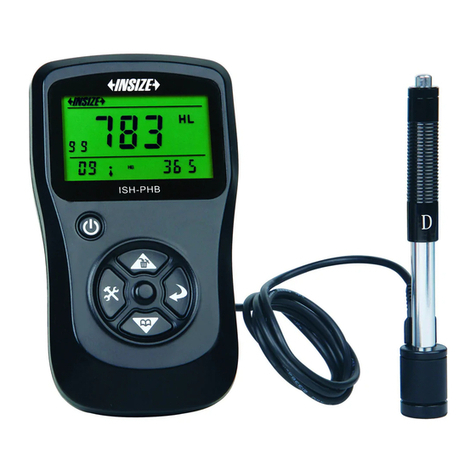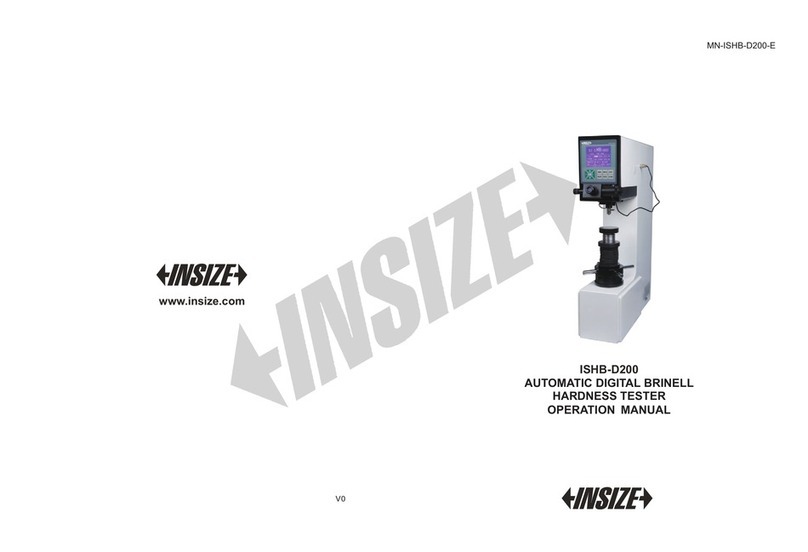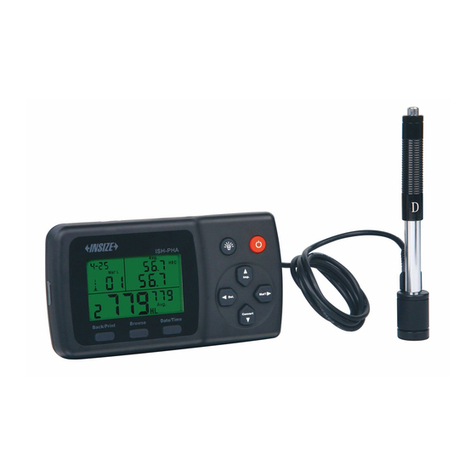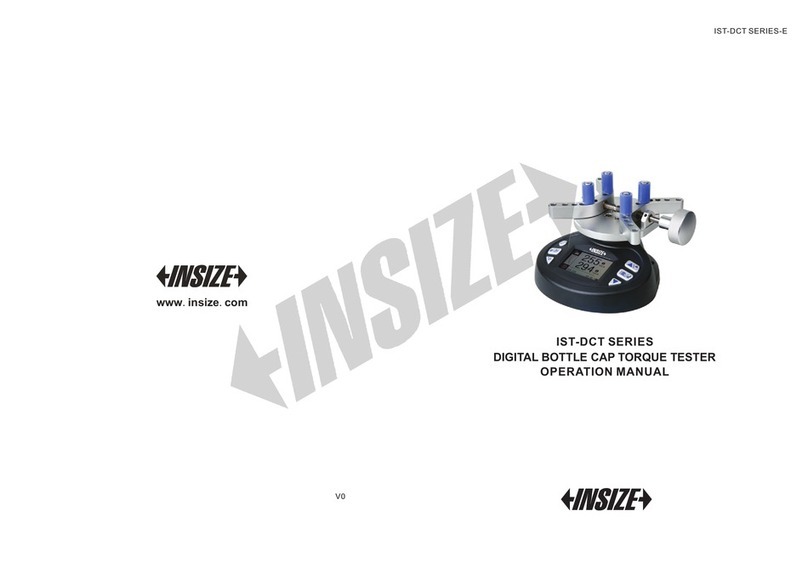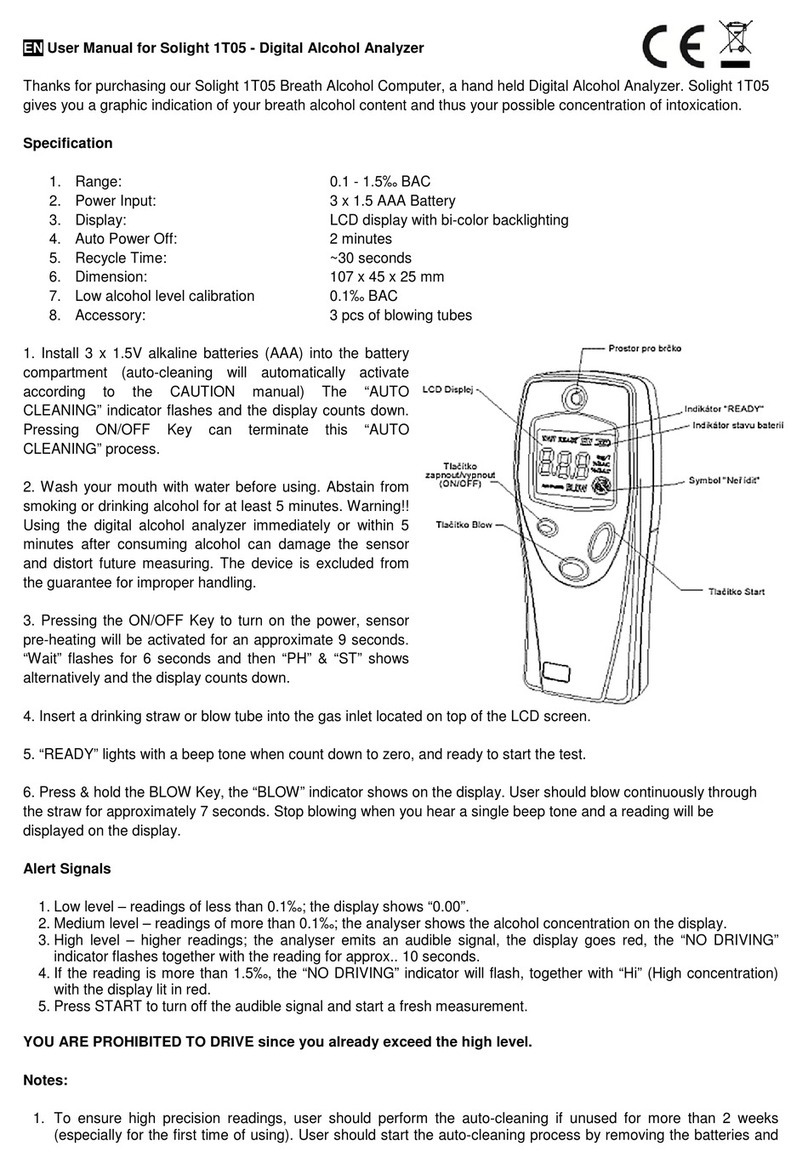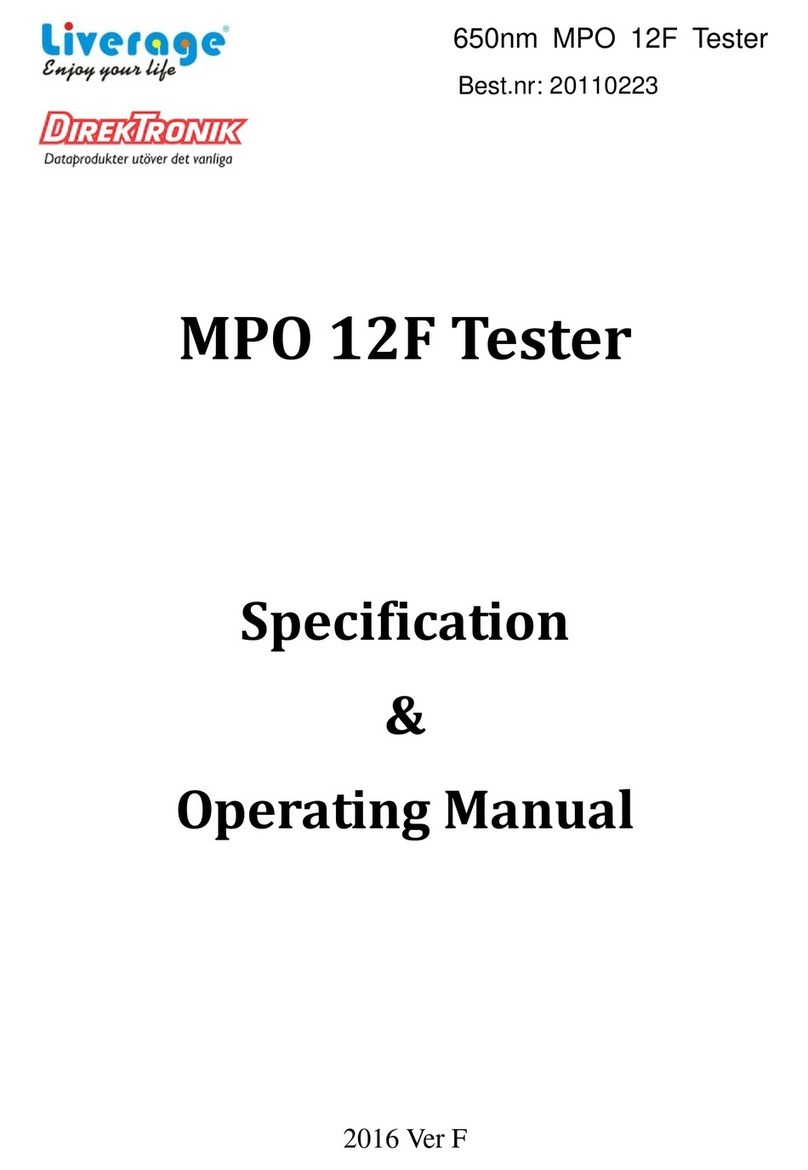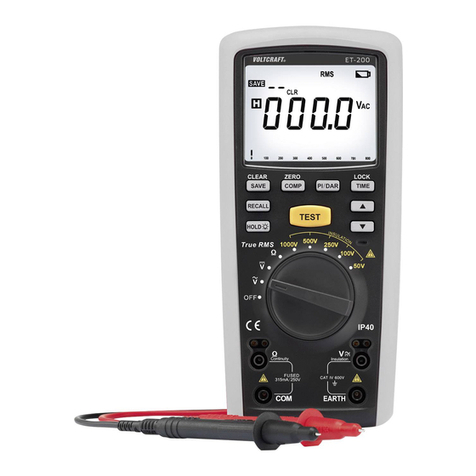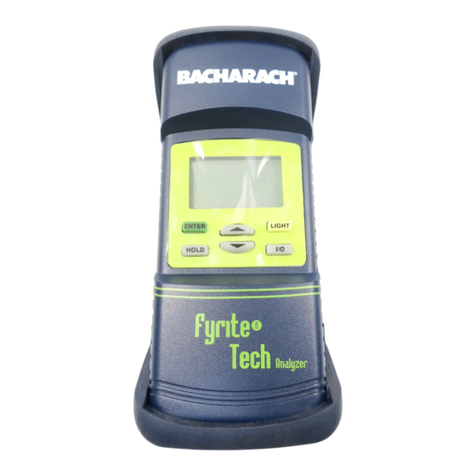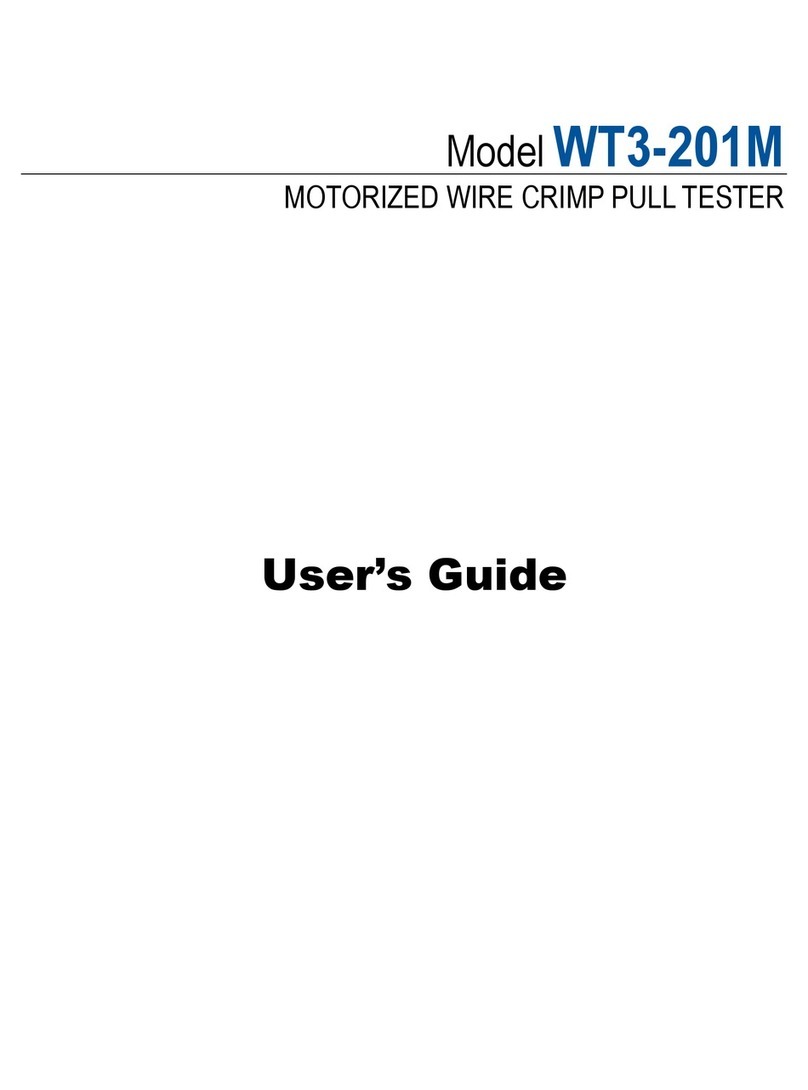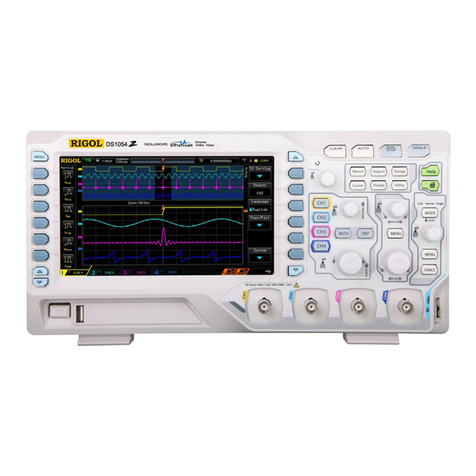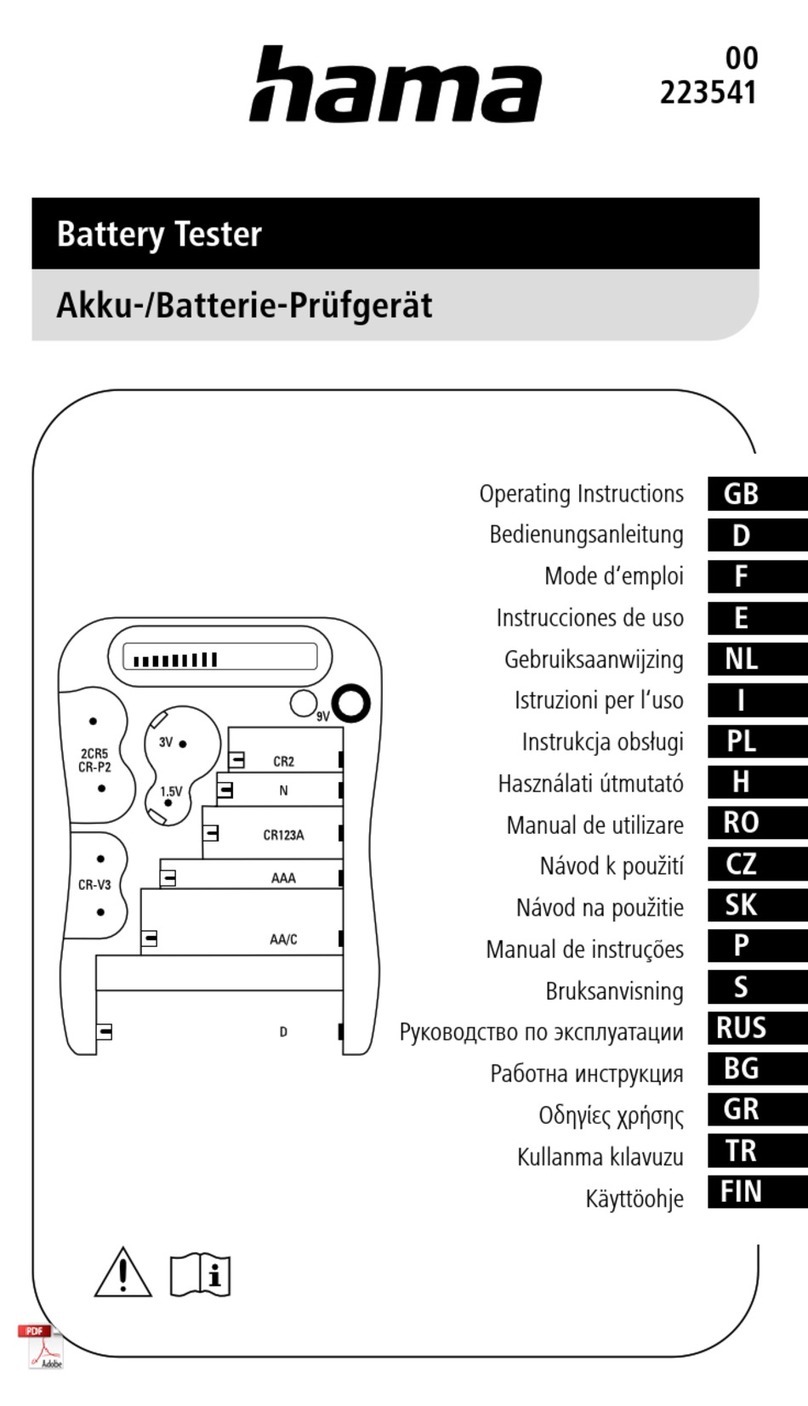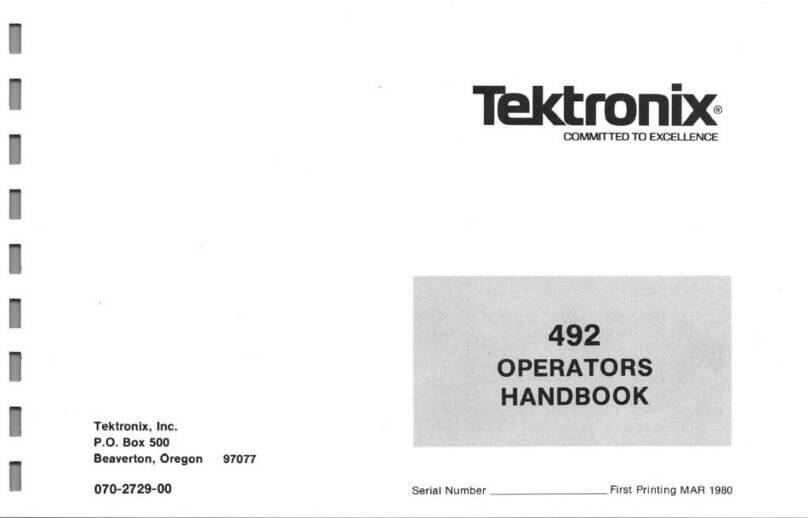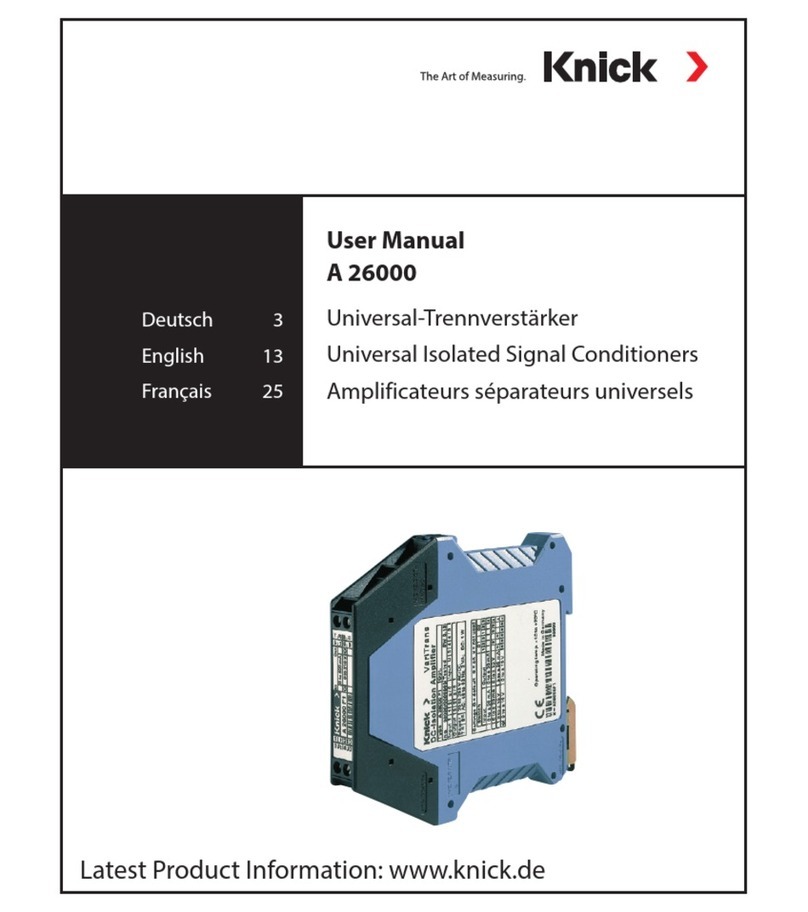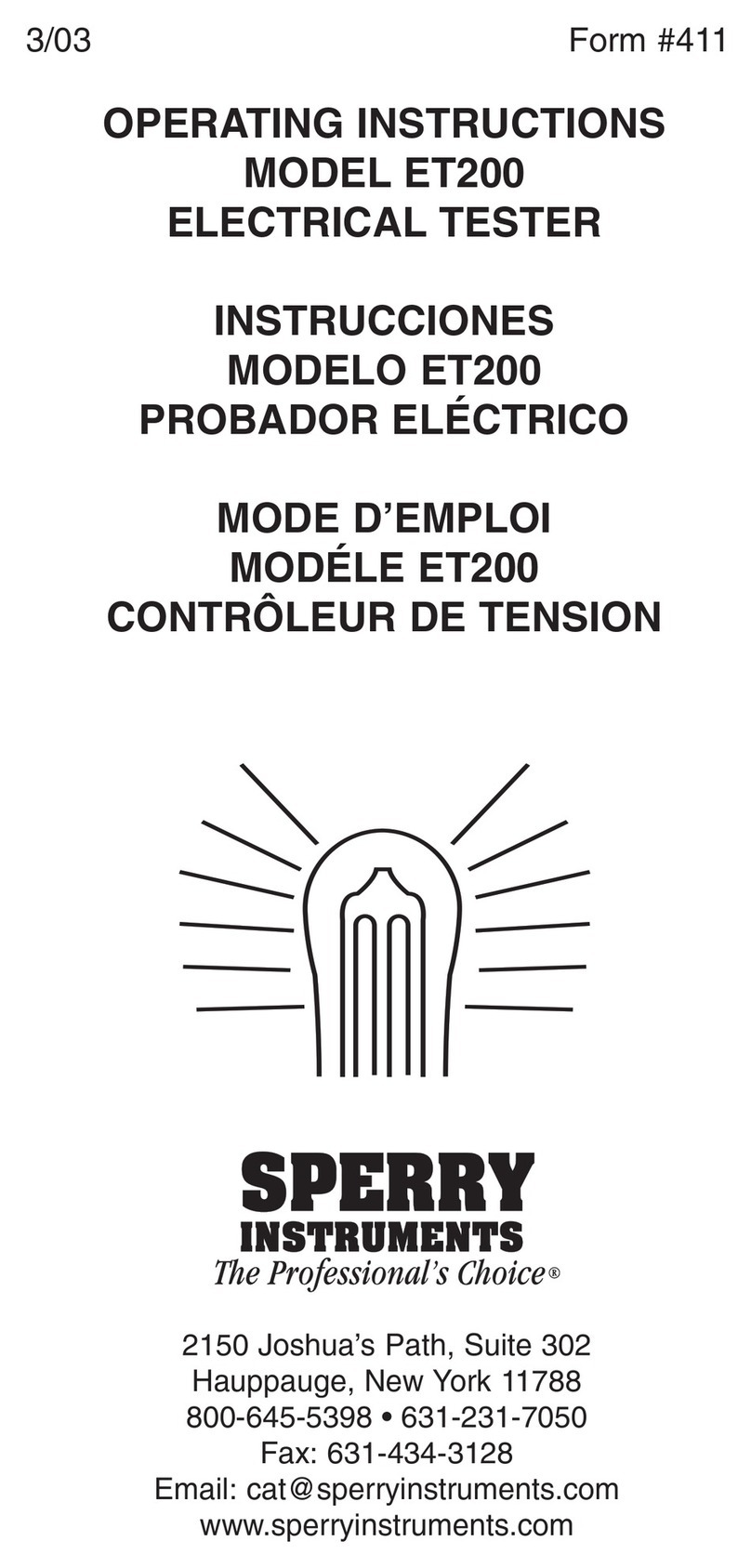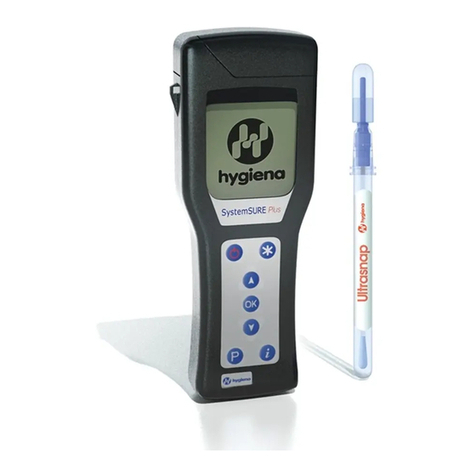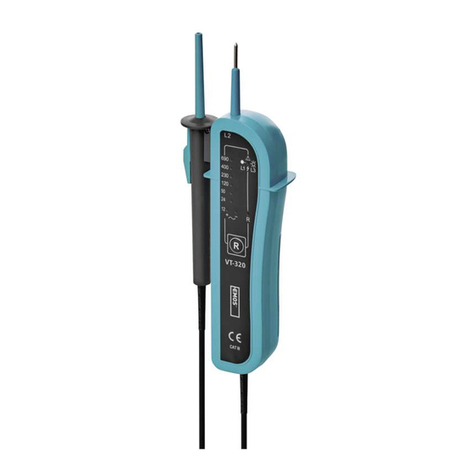insize ISH-MR150 User manual

www.insize.com
OPERATION MANUAL
ISH-MR150
AUTOMATIC ROCKWELL HARDNESS TESTER
MN-ISH-MR150-E

1 2
The power socket for this apparatus shall be of a one-way 3-pin
type, the earth terminal shall meet the specified requirements of
grounding protection.
This instruction manual shall be read through prior to the use of
the apparatus, to understand the detailed operation steps and
special attentions, in order to prevent apparatus damage and/or
personal injury resulted from improper operation.
All bands and shake-reducing tapes shall be carefully removed
before apparatus installation and calibration.
It is strictly prohibited to tamper with the installation position of all
electric elements. Switches, sockets etc. It may cause damage
and/or injury.
It is not permitted to rotate the pressure selecting hand-wheel or
li f t ing screw during th e testing press u re c h arging or relievi n g
pe r i od (i. e . w h e n t he pre s s ur i z in g mo t or is o n ) o r d uri n g t he
pressure keeping pressure.
Attention
ISH-MR150 Rockwell Hardness Tester is an universalized
apparatus for Rockwell hardness determination. It can be used in
the test of Rockwell hardness of various materials. The applying
speed of test pressure can be adjusted by a buffering device, and
the change of pressure is obtained by rotating a pressure
selecting hand-wheel. Operation of the tester is quite easy, while
the performance is stable and thus the tester can be used in a
wide range.
Working principle of the Rockwell hardness tester. The test
procedure employs a conical diamond indenter or ball indenter of
a certain diameter to press into the specimen, an initial test
pressure P and a main test pressure P will be applied on the
0 1
indenter in sequence, and the total pressure (P + P ) will be kept
0 1
for a certain period, then the main pressure is to be removed, only
the initial pressure will be left. A difference e between the indent
depth h by this time and the indent depth h under the action of
1 0
initial pressure, is recorded as a permanent increment of indent
depth. Every 0.002 mm of this increment represents a unit of
Rockwell hardness. This is a quick test and only trivial indent will
be caused, so it is widely used to determine the hardness of
specimen.
Calculation formula of Rockwell hardness test:
HRA(C)= 100 - e/0.002
H R B = 1 3 0 - e / 0 . 0 0 2
e=h - h
1 0
Description
1
2
3
Working conditions of the tester:
Under ambient temperature, i.e. between 10-30 ºC;
The relative humidity in test room shall not be over 65%;
In an environment free from vibration;
Installation
1
No corrosive medium in surrounding.

16. Beam
17. Hoist Eye
18. Hanger
19. Resting Fork
20. Weight C
21. Weight B
22. Weight A
23. Nuts
16
17
18
19
20
21
22
23
Figure 3
3 4
Tester unpacking:
Open the packing box cover and take out all cushion
materials. Remove the accessory box.
Lift the bottom plate, unscrew the two (2) M 10 bolts under the
bottom plate with a spanner, to separate the hardness tester
from bottom plate, all steps shall be done in a safe manner.
After unpacking, the tester shall be placed on a stable bench
with levelness deviation less than 1 mm/m. A hole shall be
drilled at an appropriate location on the bench (see figure 1) to
enable the lifting screw to operate properly.
Figure 1
After the hardness tester is properly placed (see figure 2),
remove the top cover. Untie the fastening white gauze tape on the
extension rod ( figure 4), then promptly replace the top cover to
prevent dust from coming into the tester. Open the rear cover
and remove the white gauze tape on moveable parts.
2
3
Wipe off the anti-rust oil on the lifting screw and apply some thin
lubricating oil instead.
Figure 2
Installation of weights (figure 3):
During weights installation the tester shall be at a test pressure-
free state.
Take the weights out of the accessory box and rub them clean.
Rotate the pressure selecting hand-wheel to position 588, take
out the hanger from rear cover, and lead the hanger into the hole
on weight A, then tighten the two M10 nuts at the end of hanger,
hook the hanger onto the hoist eye at the rear of beam , and put
weight B and weight C on two resting forks respectively. Then
turn the pressure selecting hand-wheel a whole cycle and ensure
that the weights' pins shall fall into the groove on the resting
forks.
4
1. Indicator Light 2.Top Cover 3. Rear Cover 4. Panel
5. Indenter Locking Screw 6. Indenter 7. Test Stock
8. Lifting Screw Cover 9. Turn Wheel 10. Start Button
11. Power Source Plug 12. Potentiometer 13. Fuse
Plug 14. Switch 15. Pressure Selecting Hand-wheel

5 6
Relationship between selected test pressure and applied
weights is shown as follow:
Hanger + Weight A + Weight B + Weight C
Hanger + Weight A + Weight B
Hanger + Weight A
Applied Weights
Test Pressure
Graduation, N
588
980
1470
Scale
HRA
HRB
HRC
5
Preparation prior to the use:
Surface of the specimen to be tested must be smooth and
clean, free from dirt, scaling, indentation or significant marks
resulted from machining. Scale, Indenter, Testing Pressure
and Applicable Range for Rockwell Hardness Test .
Operation
1
Minimum thickness of the specimen shall be larger than 10
times the depth of indenture. No obvious deformation shall be
seen on back of the specimen after hardness test.
The specimen to be tested shall be placed in stable state on
top of the test stock. It shall be fixed during the test process.
Ensure that the test pressure is perpendicularly exerted on
the specimen.
In case of a cylindrical shape specimen to be tested, the V
type test stock shall be used and offset needs to be made to
the values. Offset for cylindrical shape specimen shall be a
positive value.
Scale
A
D
C
F
B
G
H
E
K
Indenter
Diamond indenter
conical angle:
120 spherical
radius at vertex:
0.2 mm
°
Ball indenter
diameter:
1.5875mm (1/16in)
Ball indenter
diameter:
3.175mm (1/8in)
Initial
Pressure
(N)
98.07
Combined
Pressure
(N)
588.4
980.7
1471.0
588.4
980.7
1471.0
588.4
980.7
1471.0
Applications
hard alloy, carbide for
surface quenched steel,
hard steel sheet
thin steel sheet, surface
quenched steel
quenched steel, tempered
steel, hard cast iron
cast iron,a luminum,m agnesium
alloy, bearing alloy, annealed
copper alloy, mild steel sheet
mild steel, aluminum alloy,
copper alloy, malleable cast
iron, annealed steel
phosphorus iron, beryllium
bronze, malleable cast iron
aluminum, zinc, lead etc.
bearing alloy, tin, hard plastics,
and other soft materials
The most commonly used scales for Rockwell hardness test are A, B and C.
Hardness tester operation procedure:
2
Plug the power cord and turn on the boat-shape switch. The
illuminating light is on.
Choose a scale according to table based on the rough
hardness of the material to be tested. Rotate the pressure
selecting hand-wheel clockwise to set the total pressure.
When use the diamond indenter, press the head of diamond
with middle finger and gently push it into the hole on indenter
rod till it rests neatly on the supporting surface, then slightly
tighten the indenter locking screw, and place the specimen on
test stock.
Rotate the turn wheel clockwise to let the lifting screw move
upward, ensuring that the specimen to be tested slowly
contact with the indenter with no impact, till the short pointer
on the centigrade panel turn from the first step black point to

7 8
the red one, and by this time the long pointer shall have
passed three circles and point to position “C” (or position “B”in
case of HRB determination), which indicates that the initial
test pressure of 98.07N is achieved. The deviation of long
pointer shall not exceed 5 grades, otherwise the pointer shall
not be allowed to turn back, instead that the test spot shall be
changed to restart the operation.
Rotate the graduation dial to set the pointer on position “C”.
The value pointed by the long pointer on centigrade panel at
this time shall be taken as the determined hardness value of
the specimen (in case of HRB determination, value shall be
read from the inner circle).
Rotate the lifting wheel counterclockwise to lower the test
stock. Repeat above procedure at various spots.
No less than 5 spots shall be tested for each specimen (first
spot will not be accounted). Number of test spots may be
reasonably reduced in case of lot inspection.
Press the start button, motor starts to exert main test pressure
automatically. Indicative light turns off automatically.
The buzzer will sound during the total testing pressure
holding time. The total pressure holding time period is 10
seconds and can be adjusted by potentiometer.
When the total pressure is held for the predetermined period,
motor will restarts to remove the main pressure and the
indicator light will turn on.
Adjustment of the hardness value display. The accuracy of the
tester is calibrated at factory. If any error is caused by improper
handling during transportation, operator can make adequate
adjustment but in prior to do that he shall thoroughly understand
the structure and working principle of the tester apparatus. The
procedure is as following: Remove the top cover. If displayed
value is lower than the actual hardness of standard block, loosen
M4 nut and slightly turn in screw clockwise, then tighten the nut
and make the test again until the displayed value falls in the
specified tolerance. If displayed value is higher, turn the screw
counterclockwise.
3
24 Extension Rod
25 Nut
26 Screw
Figure 4
Repeatability & Tolerance of Rockwell Hardness Display Value:
Scale Hardness of
Standard Blocks
Display
Tolerance
Allowable Display
a)
Repeatablity
20HRA - ≤75HRA ±2HRA ≤0.02(100-H) or
b)
0.8 Rockwell Unit
>75HRA - ≤88HRA ±1.5HRA
20HRB - ≤45HRB ±4HRB
>45HRB - ≤80HRB ±3HRB
20 HRC - ≤70HRC ±1.5HRC
≤0.02(100-H) or
b)
0.8 Rockwell Unit
≤0.04(130-H) or
b)
1.2 Rockwell Unit
a) Where H is the mean hardness value.
b) Take the larger one of these two values as basis.
20 HRC - ≤70HRC ±1.5HRC
A
B
C

9 10
The operator shall operate the tester by following the instructions
contained in this manual. Frequent calibration against standard
blocks is necessary before and after actual tests. For tester not
frequently used, several pre-tests shall be done on the standard
blocks after the tester is turned on.
During a hardness test, it is strictly prohibited to turn the pressure
selecting hand-wheel when applying, keeping or removing the
testing pressure.
Use of the standard blocks can only be done on their working
surface. A minimum distance of 3 mm between two successive
test spots or between the center of indent and edge of the
specimen is necessary. Life period of a standard block is limited
to 2 years.
When handling the hardness tester, the extension rod shall be
fixed, and the weights and hanger shall be removed.
The hardness tester shall be kept in clean state. After completion
of testing procedure, the tester shall be covered with a dust cover.
Hardness block and indenter shall be coated with antirust oil after
use to prevent rust and corrosion.
Periodical verification shall be done, at least once a year, on the
tester so as to ensure its accuracy.
Common trouble shooting. It is recommended that the user
contact the manufacturer if problems occur with the tester.
However, the following table may help the user to detect and
solve some common problems.
Maintenance
1
2
3
4
5
6
7
Problem Possible cause Suggested remedy
The long pointer
deviates from its
zero point.
Adjustment of
displayed value may
cause deviation of the
long pointer.
Refer to figure 4.
Slightly loosen nut and
turn M4 screw in small
increment to align the
pointer onto its zero
point, then fix the screw
and fasten the nut.
Extraordinary error
occurs on display
1.Damaged indenter.
2.Wrong order of weights
placement.
3.Friction between
weights and inner wall
of the tester body caused
by unleveled installation
of the tester.
4.The dust-proof cover is
higher than the
supporting surface of
the lifting screw.
5.Wrong selection of
total test pressure or
indenter.
Replace diamond
indenter or ball indenter.
Place weights according
to figure 3.
Calibrate the tester with
a leveling instrument
Lower the dust-proof
cover to below the
upper surface of the
lifting screw and fasten
the screw.
Select appropriate test
pressure according to
table 2.
1.
3.
4.
5.
2.
Indicator lamp do
not light up when
tester is turned on
1.No power
2.Fuse blows out
3.Damaged lamp
Check if the power
cord is properly
connected.
Replace the fuse
with the new one in
accessory box.
Replace the lamp
with the new one in
accessory box.
1.
2.
3.
Minimum thickness of the sample shall be larger than 10 times the
depth of indenture. No obvious deformation shall be seen on
back of the sample after hardness test. The relationship between
minimum thickness of the sample and its hardness are shown in
the following table .
Appendix
1

Minimum thickness of the specimen (mm)
Hardness (HR)
11 12
Offsets for Rockwell hardness test when diameter of the
specimen is less than 38 (25) mm.
2
Hardness
Value
(HRC)
(HRA)
Diameter of Cylindrical Specimen (mm)
6 10 13 16 19 22 25 32 38
Offsets (HR) to Rockwell Scale C & A
20
25
30
35
40
45
50
55
60
65
70
75
80
85
90
3.0
2.5
2.0
1.5
1.5
1.0
1.0
0.5
0.5
0.5
3.0
2.5
2.0
2.0
1.5
1.0
1.0
1.0
0.5
0.5
0.5
0
3.0
2.5
2.0
2.0
1.5
1.5
1.0
1.0
1.0
0.5
0.5
0.5
0.5
0
2.5
2.5
2.0
1.5
1.5
1.0
1.0
1.0
0.5
0.5
0.5
0.5
0.5
0
0
2.0
2.0
1.5
1.5
1.0
1.0
1.0
0.5
0.5
0.5
0.5
0.5
0.5
0
0
1.5
1.5
1.5
1.0
1.0
1.0
0.5
0.5
0.5
0.5
0.5
0.5
0
0
0
1.5
1.0
1.0
1.0
1.0
0.5
0.5
0.5
0.5
0.5
0.5
0
0
0
0
1.0
1.0
1.0
0.5
0.5
0.5
0.5
0.5
0
0
0
0
0
0
0
1.0
1.0
0.5
0.5
0.5
0.5
0.5
0
0
0
0
0
0
0
0
Hardness
Value
(HRB)
Diameter of Cylindrical Specimen (mm)
6 10 13 16 19 22 25
Offsets (HR) to Rockwell Scale B
20
30
40
50
60
70
80
90
100
5.0
4.0
3.5
5.0
4.0
3.5
3.0
2.5
5.0
4.5
4.0
3.5
3.0
2.5
2.0
1.5
4.5
4.5
4.0
3.5
3.0
2.5
2.0
1.5
1.5
4.0
3.5
3.0
3.0
2.5
2.0
1.5
1.5
1.0
3.5
3.0
2.5
2.5
2.0
2.0
1.5
1.5
1.0
3.0
2.5
2.5
2.0
2.0
1.5
1.5
1.0
0.5
Specification
SPECIFICATION
Hardness scale
Test force
Display
Stage elevation
Load control
Min. reading
Max. workpiece height
Max. workpiece depth
Dimension
Weight
Preliminary test force
HRA, HRB, HRC
98N
588N, 980N, 1471N
analogue
manual
automatical (load/dwell/unload)
0.5HR
170mm
165mm (from the center of indenter)
520×160×700mm
60kg
, HRD, HRF, HRG

13
Standard Delivery
1pc
1pc
1pc
1pc
1pc
Main unit
Ø60mm flat anvil
Ø150mm flat anvil
V-type anvil
Diamond indenter
1pc
1pc
1pc
1pc
carbide indenter
Hardness test block HRB85-95
Hardness test block HRC60-70
Hardness test block HRC20-30
Ø1.5875mm ball
Table of contents
Other insize Test Equipment manuals
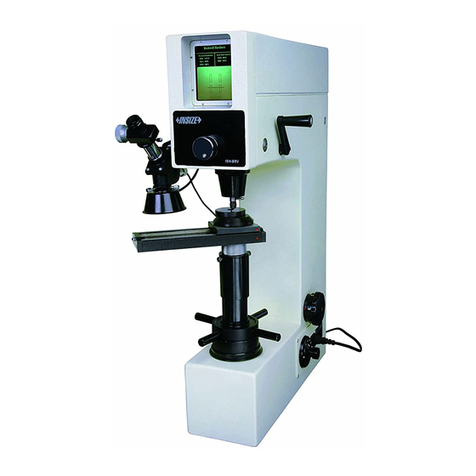
insize
insize ISH-BRV User manual

insize
insize IST-TT Series User manual
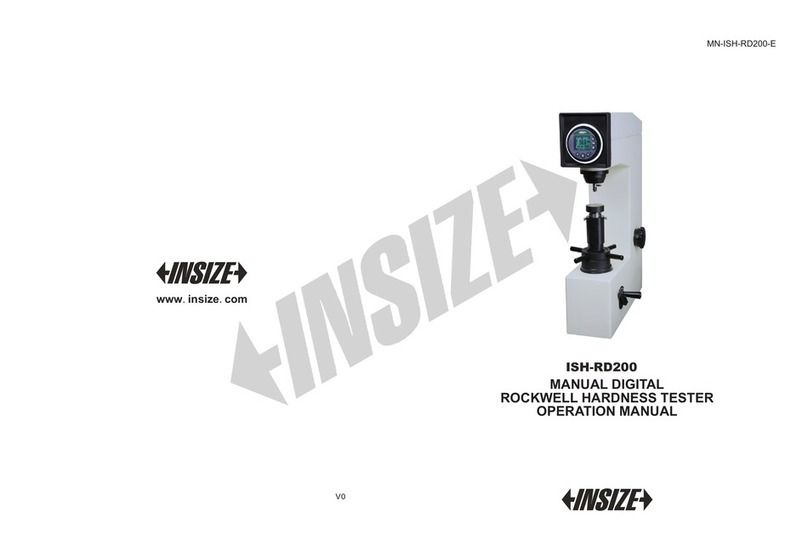
insize
insize ISH-RD200 User manual
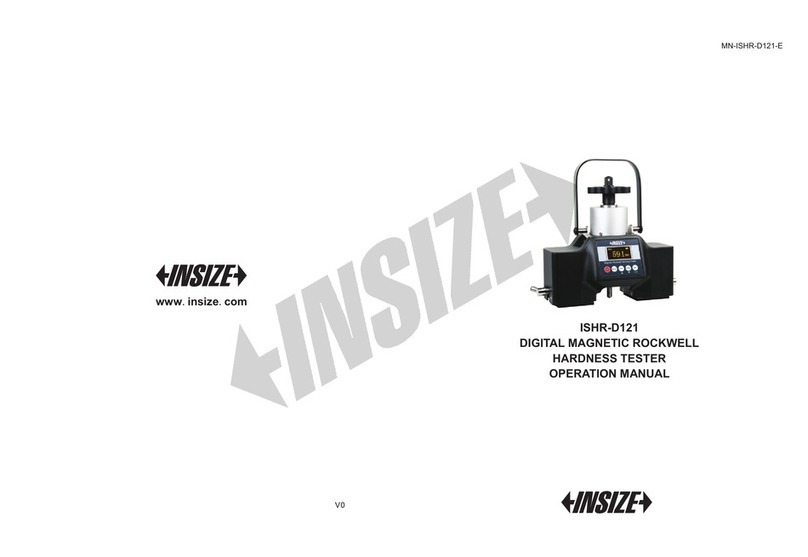
insize
insize ISHR-D121 User manual
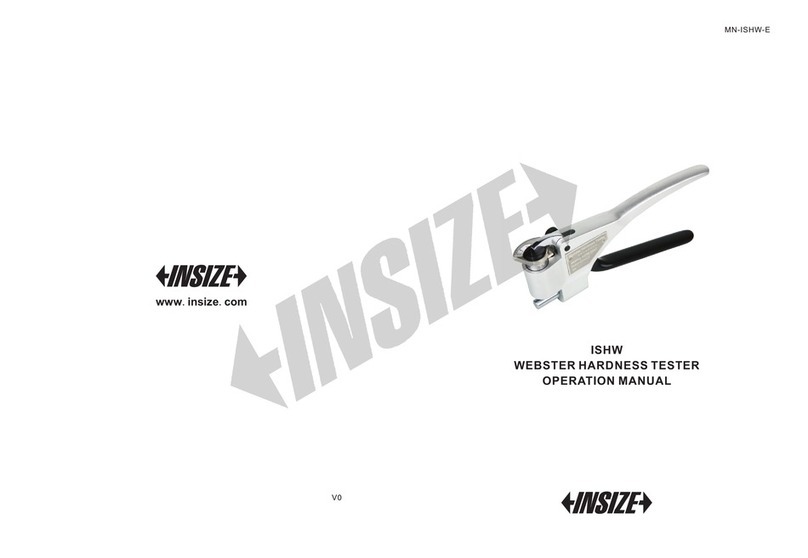
insize
insize ISHW User manual
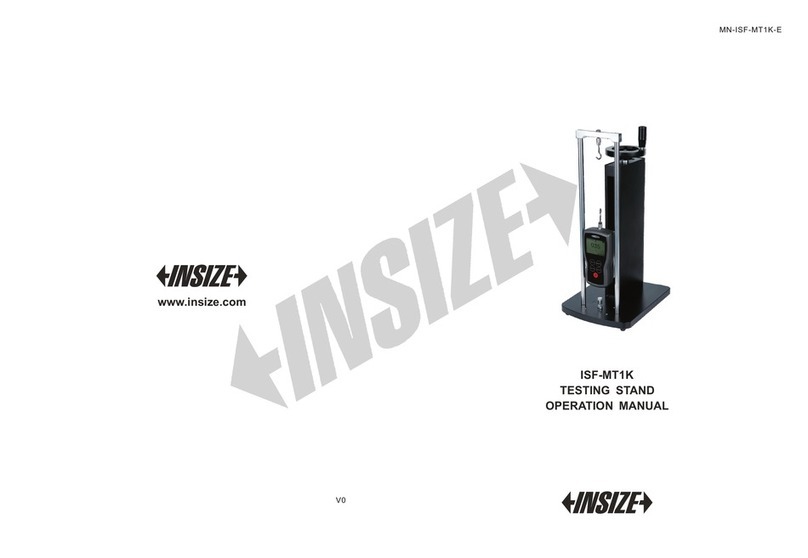
insize
insize ISF-MT1K User manual
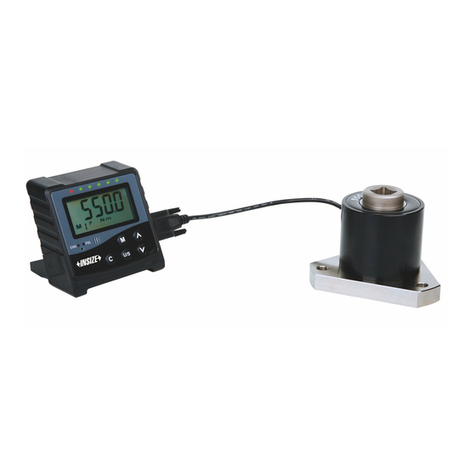
insize
insize IST-TT Series User manual
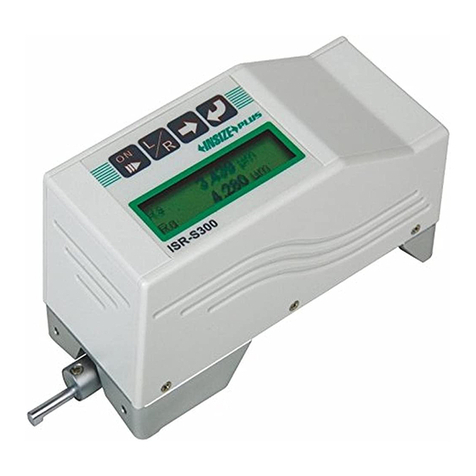
insize
insize ISR-S300 User manual

insize
insize ISHR-P151 User manual
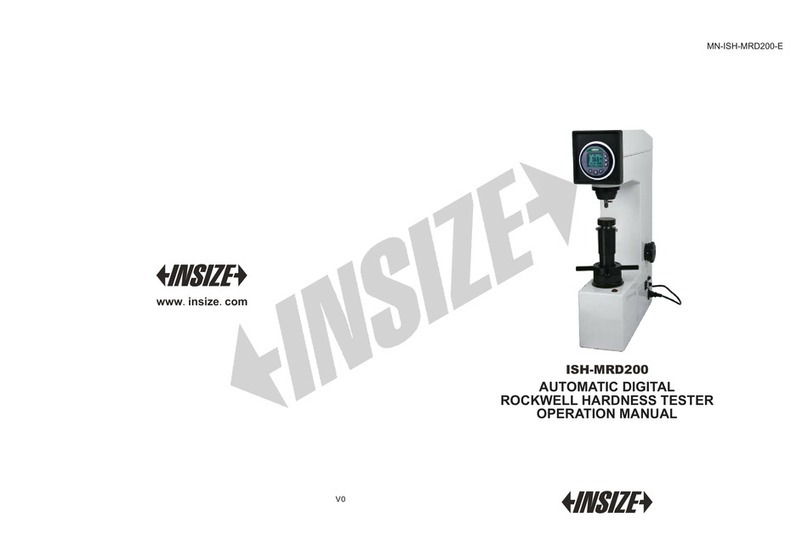
insize
insize ISH-MRD200 User manual
